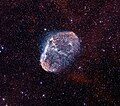astro.wikisort.org - Galaxy
The Crescent Nebula (also known as NGC 6888, Caldwell 27, Sharpless 105) is an emission nebula in the constellation Cygnus, about 5000 light-years away from Earth. It was discovered by William Herschel in 1792.[2] It is formed by the fast stellar wind from the Wolf-Rayet star WR 136 (HD 192163) colliding with and energizing the slower moving wind ejected by the star when it became a red giant around 250,000[3] to 400,000[citation needed] years ago. The result of the collision is a shell and two shock waves, one moving outward and one moving inward. The inward moving shock wave heats the stellar wind to X-ray-emitting temperatures.
| Emission nebula | |
|---|---|
 The Crescent Nebula, as taken by an amateur astronomer | |
| Observation data: J2000.0 epoch | |
| Right ascension | 20h 12m 7s[1] |
| Declination | +38° 21.3′[1] |
| Distance | 5,000 ly |
| Apparent magnitude (V) | +7.4 |
| Apparent dimensions (V) | 18′ × 12′ |
| Constellation | Cygnus |
| Designations | NGC 6888,[1] Sharpless 105, Caldwell 27 |
It is a rather faint object located about 2 degrees SW of Sadr. For most telescopes it requires a UHC or OIII filter to see. Under favorable circumstances a telescope as small as 8 cm (with filter) can see its nebulosity. Larger telescopes (20 cm or more) reveal the crescent or a Euro sign shape which makes some to call it the "Euro sign nebula".
- NGC 6888 in Hydrogen and Oxygen Light. HOO Pallet. Imaged by Don Christopher Deaver
- Crescent Nebula in H-alpha and OIII. Imaged with a 715mm focal length telescope. The hydrogen gas is red. The oxygen is blue.
- Image of NGC 6888 using H-alpha filter.
- Picture of NGC 6888 captured in narrowband by amateur astronomer Luca Moretti
- NGC 6888 imaged in 3 nm hydrogen-alpha and oxygen-III narrowband at 2800mm focal length by amateur astronomer Patrick Hsieh.
See also
- Cygnus Bubble
References
- "NGC 6888". SIMBAD. Centre de données astronomiques de Strasbourg. Retrieved 2007-04-23.
- Erdmann, Robert. "NGC 6888". The NGC/IC Project. Archived from the original on 2012-05-20.
- "WR 136". jumk.de. Retrieved 25 March 2018.
External links
- "Crescent". National Optical Astronomy Observatory.
- "Crescent Nebula: Live Fast, Blow Hard and Die Young". Chandra X-Ray Observatory. 14 October 2003.
- Crescent Nebula on WikiSky: DSS2, SDSS, GALEX, IRAS, Hydrogen α, X-Ray, Astrophoto, Sky Map, Articles and images
- Nemiroff, R.; Bonnell, J., eds. (11 November 2007). "NGC 6888: The Crescent Nebula". Astronomy Picture of the Day. NASA. Retrieved 25 March 2018.
На других языках
[de] NGC 6888
NGC 6888 ist ein Emissionsnebel im Sternbild Schwan, der 4700 Lichtjahre von der Erde entfernt ist. Er wird auch Crescent Nebel, Sichelnebel oder Mondsichelnebel genannt. NGC 6888 wird von einem sogenannten Wolf-Rayet-Stern mit der Bezeichnung WR 136 beleuchtet. Vermutlich wurde das Gas des Nebels ebenfalls von diesem Stern abgestoßen.- [en] Crescent Nebula
[es] NGC 6888
La nebulosa Medialuna (NGC 6888), también llamada nebulosa Creciente o Caldwell 27, es una nebulosa de emisión en la constelación de Cygnus, situada 6º al suroeste de Sadr (γ Cygni). Se encuentra a unos 4700 años luz de distancia de la Tierra.[ru] Туманность Полумесяц
NGC 6888 (другое обозначение — LBN 203) — эмиссионная туманность в созвездии Лебедь. Размеры туманности составляют примерно 25 на 18 световых лет. Она располагается на расстоянии примерно 4700 световых лет от Земли. NGC 6888 образовалась в результате выбросов супергиганта HD 192163, расположенного в центре туманности. Масса этого светила составляет около 10 солнечных.Другой контент может иметь иную лицензию. Перед использованием материалов сайта WikiSort.org внимательно изучите правила лицензирования конкретных элементов наполнения сайта.
WikiSort.org - проект по пересортировке и дополнению контента Википедии




